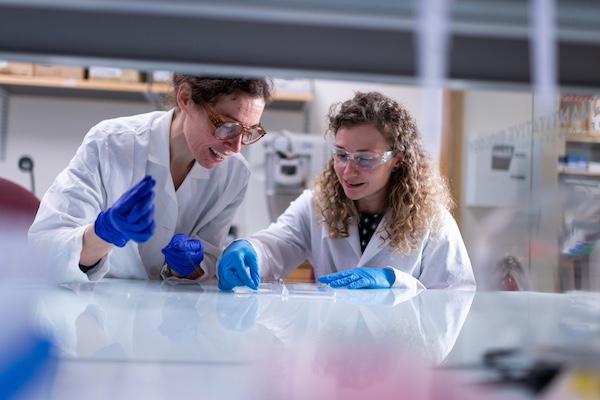During a special event on Thursday, Nov. 21, Morgridge Investigator Josh Coon and his team opened their lab doors for a group of enthusiastic, science-curious donors and supporters to take a closer look at the lab’s mass spectrometry technology and innovative metabolism research.
“The Morgridge Institute really gives our team the confidence and the support we need to take high risk, high reward science,” says Coon, the Thomas and Margaret Pyle Chair in Metabolism. “It has really changed how we the approach the problems that we think about tackling.”
Guests interacted with Coon Lab scientists at hands-on exploration stations to learn about metabolism research methods including mass spectrometry, thin-layer chromatography, paper spray technology and cryo-electron microscopy (cryo-EM).
“This technology is very prevalent, and our lab is trying to innovate the technology,” Coon says. ” We use those technologies in collaboration with people here at the university, at the institute, and across the world to study diseases like Alzheimer’s disease, cancer, liver disease, several metabolic diseases and many others,” Coon says.
Through thoughtful questions and engaging conversations, attendees developed a stronger understanding how “fearless science” facilitates understanding of biological properties that can be applied to improving patient care and health outcomes.
View photos of the event below (photo credit: Sharon Vanorny).
 The Josh Coon Lab
The Josh Coon Lab  Josh Coon, the Thomas and Margaret Pyle Chair in Metabolism at the Morgridge Institute, offers opening remarks to guests before entering the lab spaces.
Josh Coon, the Thomas and Margaret Pyle Chair in Metabolism at the Morgridge Institute, offers opening remarks to guests before entering the lab spaces.  The lab demonstrates how mass spectrometry instruments can be used to identify and distinguish between different whiskeys.
The lab demonstrates how mass spectrometry instruments can be used to identify and distinguish between different whiskeys.  In this demo, guests observed how paper spray technology can quickly identify materials such as traces of cocaine on dollar bills.
In this demo, guests observed how paper spray technology can quickly identify materials such as traces of cocaine on dollar bills.  Participants observed live tardigrades under a microscope, comparing them to a 3D printed model as well as learning how cryo-EM can visualize deeper biological structures.
Participants observed live tardigrades under a microscope, comparing them to a 3D printed model as well as learning how cryo-EM can visualize deeper biological structures.  In a rare occasion to play with food in the lab, guests used thin-layer chromatography to separate molecules in colored food extracts.
In a rare occasion to play with food in the lab, guests used thin-layer chromatography to separate molecules in colored food extracts.  How does a mass spectrometry instrument work? The lab offered a close look at the various parts of a deconstructed instrument.
How does a mass spectrometry instrument work? The lab offered a close look at the various parts of a deconstructed instrument.  Piecing all the parts together in their mind, guests learn more about the mechanics of mass spectrometry and its role in research.
Piecing all the parts together in their mind, guests learn more about the mechanics of mass spectrometry and its role in research. 
